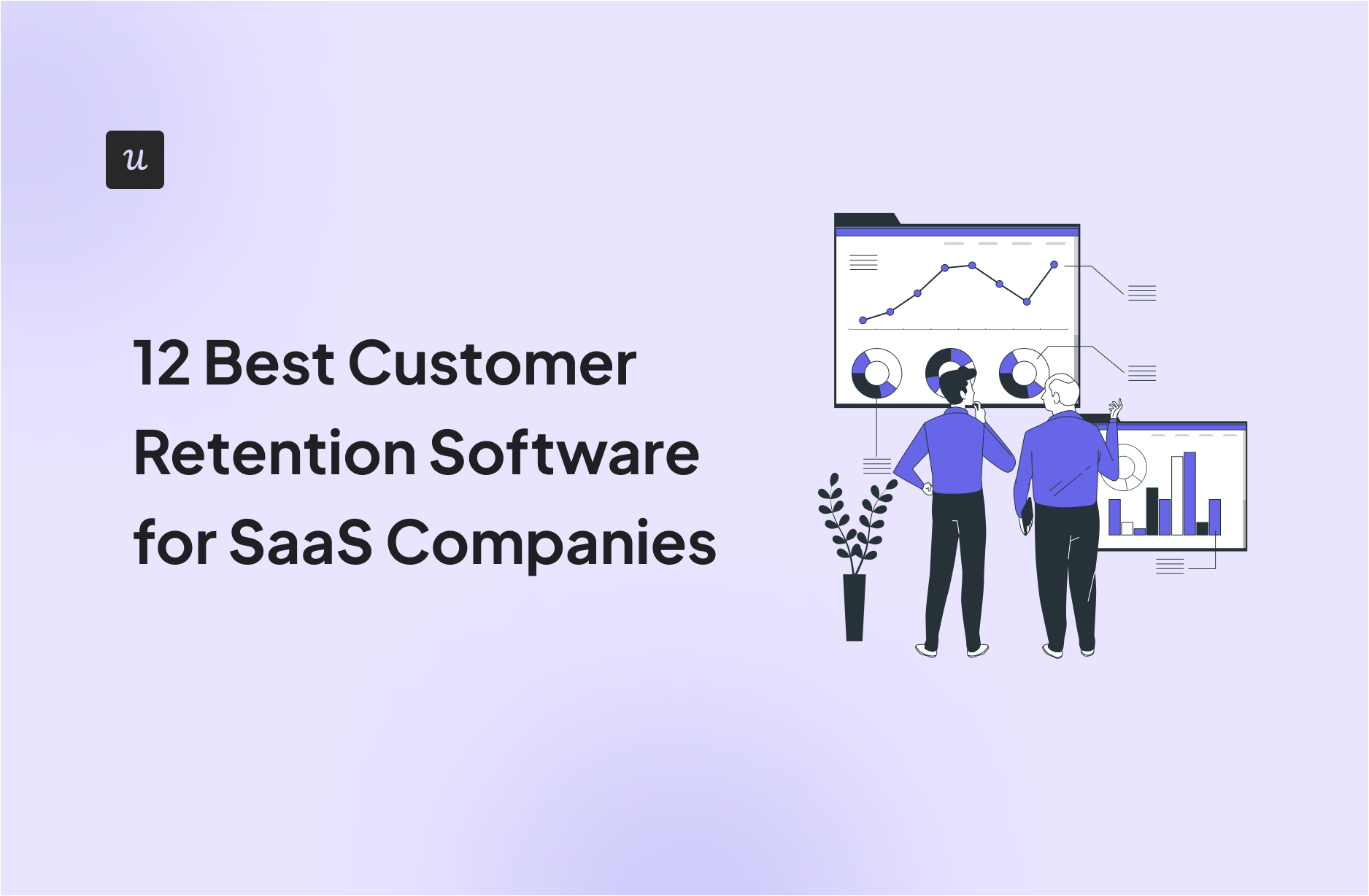
Are you on the lookout for tools that can help you improve customer retention?
There are quite a few solutions around, so it might be difficult to find, especially as we’re not talking about one specific set of tools but rather a whole range of different solutions covering a range of use cases.
This article shows what you should look for when choosing customer retention software and showcases 12 tools worth considering.
Before that, though, we cover some background basics.
Try Userpilot Now
See Why 1,000+ Teams Choose Userpilot

What is customer retention software?
Customer retention software is a category of tools designed to help SaaS businesses keep their existing customers and strengthen their loyalty.
To help you achieve this, such software includes a range of features enabling user behavior analytics, feedback collection, or personalized in-app communication, to name just a few.
Why invest in customer retention management software?
Freemium retention software isn’t likely to satisfy your needs and you will have to pay for a subscription, and often not just one. In most cases, though, it’s totally worth it.
Reduced customer acquisition efforts and costs
Retaining customers costs less than acquiring new ones. So, if your funnel is leaky and you can’t retain customers, growth may be unsustainably expensive.
Better yet, good retention can actually make it easier to acquire new customers. Loyal customers are more likely to become product advocates and promote your product for you via WOM.
Increased customer satisfaction and lifetime value
One of the reasons why customers stay with you is that they’re satisfied with the value your product offers and the customer experience you provide. So, in other words, customer retention software can help you make your product more attractive to customers.
And did you know that existing customers are considerably more likely to buy new products or upgrade? The odds are 60-70% vs 5-20% for new customers! So, by retaining customers, you increase their lifetime value.
Improved revenue forecasting
Customer retention affects revenue in 2 main ways:
- It increases the overall revenue.
- It makes the revenue stream more stable and predictable.
The latter means that it’s easier for businesses to plan and allocate their resources to initiatives that lead to long-term growth, like research and development.
What’s the biggest hurdle in your customer retention strategy right now?
How do you currently guide users inside your app?
What’s the most critical capability for your ideal customer retention software?
You’re ready to proactively boost retention.
To reduce churn and increase lifetime value, you need a customer retention software that lets you analyze user behavior, create personalized in-app experiences, and gather contextual feedback—all without writing code. Userpilot combines these powerful features into one platform designed to turn users into loyal advocates.
Different types of customer retention software
As mentioned, there’s no one customer retention tool to tick all your boxes and you’re most likely going to need a few different applications.
Product growth tools
Product growth tools provide teams with the functionality necessary to drive product activation, adoption, retention, and other key metrics.
Their main functionality revolves around user in-app engagement. They allow you to create in-app experiences that provide guidance and help users achieve their goals.
Most of the tools around also have solid feedback features and some – excellent analytics.
Customer relationship management tools
Customer relationship management (CRM) platforms store customer data, track communication history, and provide insights to personalize customer interactions.
Most of them integrate with engagement, marketing, and analytics tools and act as the central hub from which you can manage interactions with current and potential customers.
Customer support software
Customer support software focuses on managing and improving the customer service process.
These tools streamline support operations, track customer issues, and provide self-service options to ensure that customers get the assistance they need to maximize product value and enhance the overall customer experience.
Customer feedback tools
Customer feedback tools are designed to collect and analyze feedback from customers.
They provide valuable insights into their experiences and satisfaction levels, help you identify areas for improvement, and address customer pain points.
Data analysis tools
Data analysis tools enable you to track user behavior at different stages of the customer journey and analyze them.
Their purpose is to give you the data necessary to make informed prioritization and optimization decisions. For example, you can use them to identify friction in the user experience that leads to churn.
Marketing automation tools
Marketing automation tools streamline and automate your marketing efforts.
Such tools make it easier to engage with customers through personalized and consistent communications across multiple channels, which is essential for nurturing customer relationships.
What are the top features to look for in customer retention tools?
Your customer retention tool stack should enable you to:
- Create detailed customer profiles and use the data for segmentation.
- Create and orchestrate personalized campaigns across various channels.
- Run email and in-app surveys to collect customer feedback and track satisfaction levels.
- Analyze user in-app interactions and campaign performance and use the insights to predict future behavior.
- Create custom reports and dashboards.
- Set up loyalty programs.
- Automate workflows and integrate multiple products for seamless data syncing.
- Navigate your product easily without friction and usability issues.
12 Top customer retention software tools
With the theory out of the way, here are our 12 customer retention software picks.
1. Userpilot
Userpilot is a product growth platform. It’s designed for medium-sized and large B2B companies that want to boost their growth rates by improving product adoption and customer retention.
Userpilot’s engagement features include :
- UI patterns (tooltips, modals, banners, slideouts, hotspots, and driven actions).
- Interactive walkthroughs.
- Checklists.
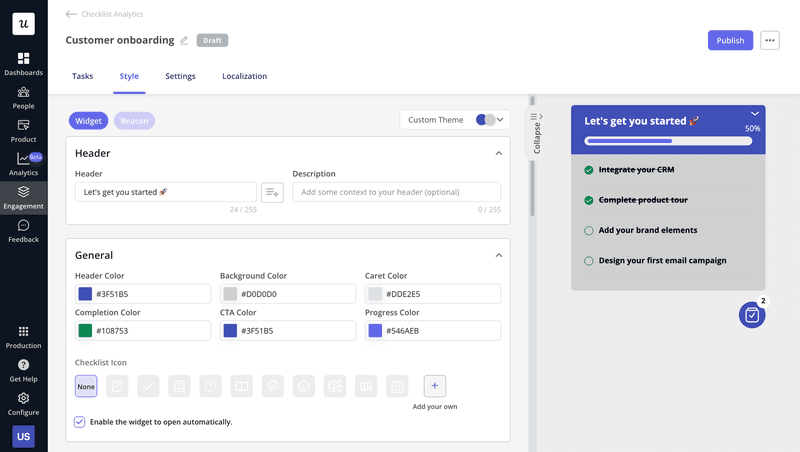
Userpilot analytics make the tool stand out from its competitors. Some of the most prominent features include:
- No-code feature tagging.
- Custom event tracking.
- Trends, Funnel, Paths, and Retention reports.
- A/B and multivariate testing.
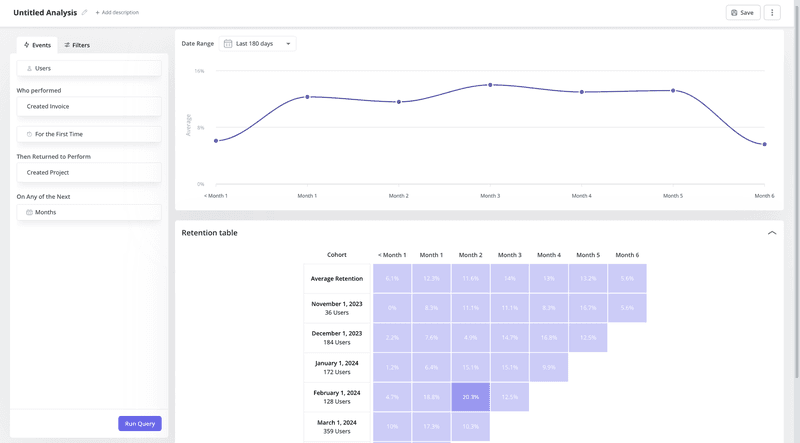
Recently, Userpilot launched custom dashboards so you can track all relevant metrics from one place without switching between tools and reports.
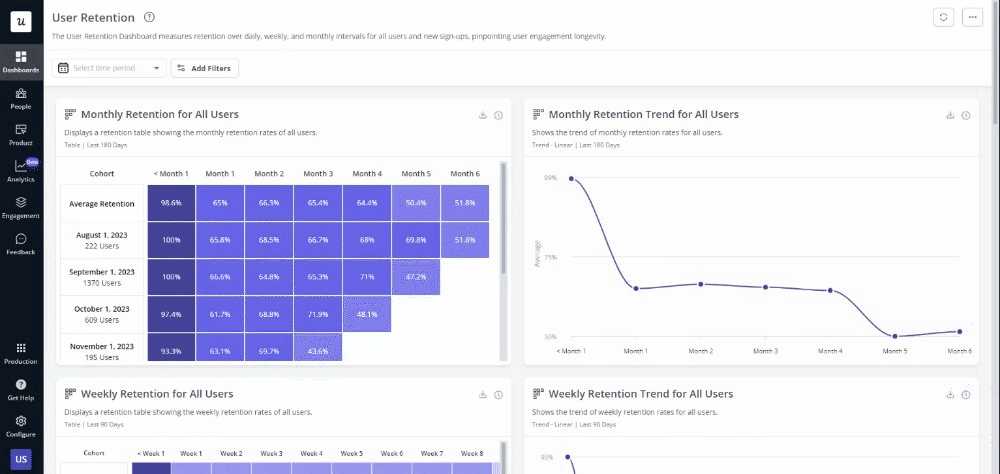
The Userpilot team recognizes the importance of self-service support. This is covered by the resource center functionality, where you can include your knowledge base with guides and product docs, tutorials, and a chatbot or live chat widget.
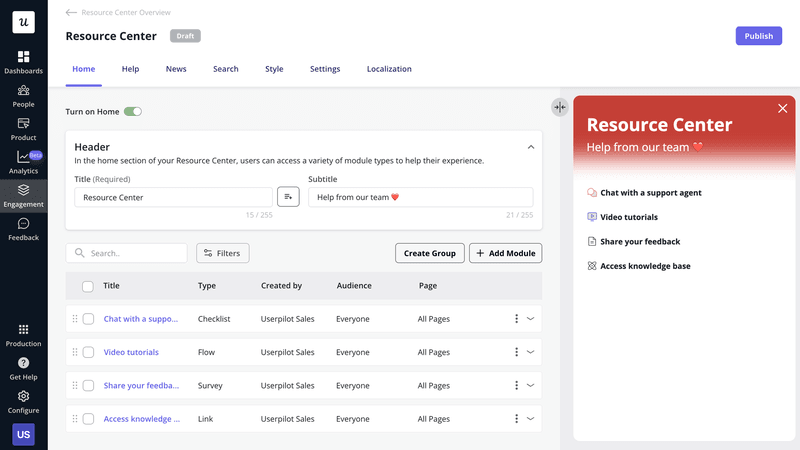
Finally, Userpilot offers a host of integrations with the most popular analytics, customer support, and CRM tools like Amplitude, Segment, Google Analytics, Hubspot, and Salesforce.
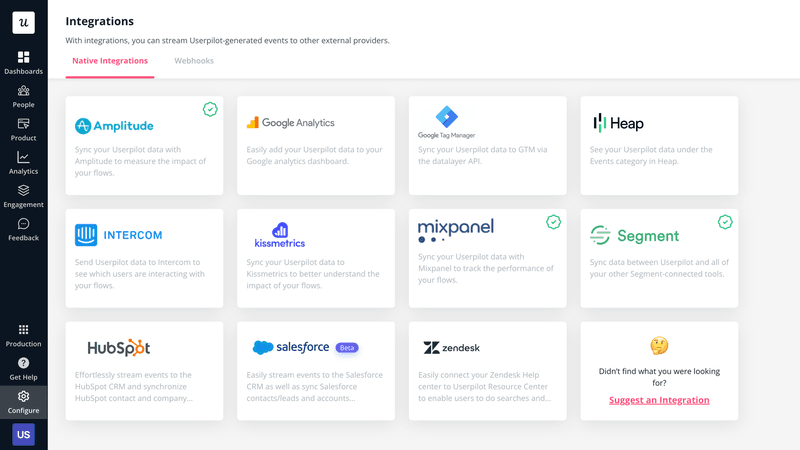
2. Appcues
Appcues is another digital adoption platform with a similar target audience.
Just like Userpilot, it enables you to create onboarding flows and in-app experiences to engage customers along the user journey.
You can also use it to collect customer feedback via in-app surveys.
Analytics haven’t been the Appcues team’s priority, and they’re a bit lacking when compared to Userpilot. They’re okay for tracking user engagement with the in-app guides, but for in-depth user behavior analytics, you need to integrate it with one of the 3rd party analytics tools.
However, it does have one advantage over Userpilot: it supports mobile apps as well. So if you need a tool for mobile app onboarding, Appcues is worth considering.
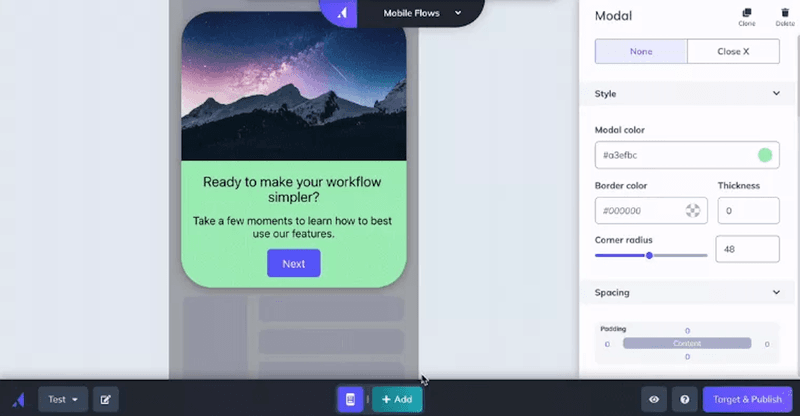
3. Zendesk
Zendesk is a customer service software. It offers a comprehensive suite of tools for managing customer interactions across various channels, including email, chat, phone, and social media.
Businesses use Zendesk to streamline their customer support processes, improve communication with customers, and gain insights into customer behavior.
Zendesk supports:
- Omnichannel communication.
- A unified agent workspace where they can analyze and coordinate all customer interactions.
- Automated support ticket-routing and tracking.
- Help center and knowledge base for self-support.
- CRM features (user profiles, interaction history).
- Integrations with 1500 apps, including most analytics, marketing automation, and CRM platforms.
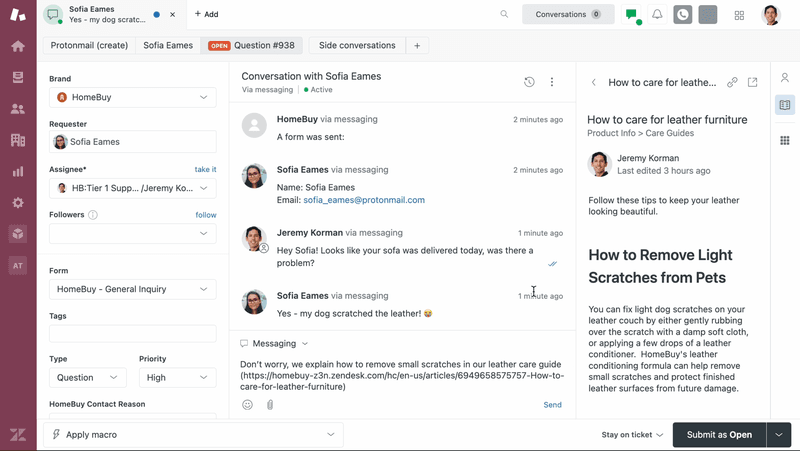
4. HubSpot
HubSpot is one of the best-known CRM platforms. Comprehensive yet intuitive and user-friendly, it gives businesses all the tools that they need to manage and nurture their relationships with customers.
HubSpot’s main features include a centralized customer database and interaction tracking. HubSpot logs every email, call, meeting, and so on to give you a complete overview of each customer.
The CRM seamlessly integrates with other HubSpot tools, so you can also use it to:
- Track deal progression.
- Score leads using data from various sources.
- Design and send email campaigns.
- Route and track support tickets.
- Provide support through a live chat, chatbot, or knowledge base.
HubSpot offers also plenty of integrations with 3rd party tools that expand its functionality. For example, by integrating it with Userpilot, you can use Userpilot’s analytics data for more accurate customer segmentation and marketing campaign personalization.
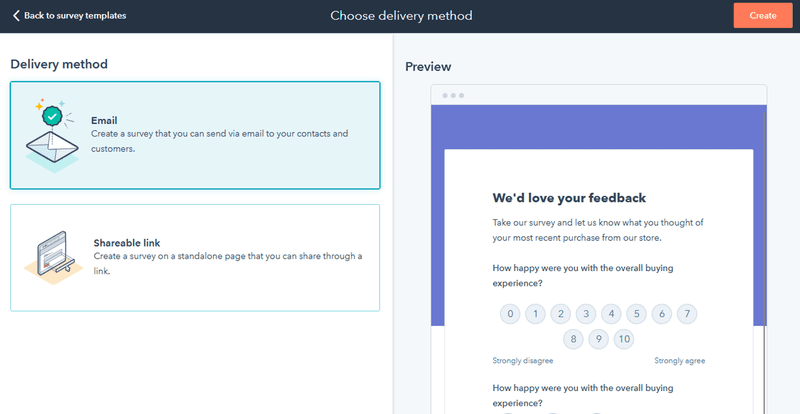
5. Salesforce
Salesforce is yet another powerful CRM software. More complex than HubSpot but also offers more advanced functionality. It gives SaaS businesses everything they need to track and cultivate strong customer relationships with their customers.
Salesforce’s suite of tools enables teams to:
- Track and resolve customer service issues with case management tools.
- Provide self-service support with a knowledge base of articles, FAQs, and guides.
- Engage with customers across multiple channels, including email, phone, chat, and social media.
- Design, send, and track email campaigns.
- Use artificial intelligence to gain insights into customer interactions and improve service quality.
Just like HubSpot, Salesforce integrates with multiple 3rd party tools for greater capabilities. Take the Userpilot integration, as an example: it allows you to import user survey results for segmentation and personalization.
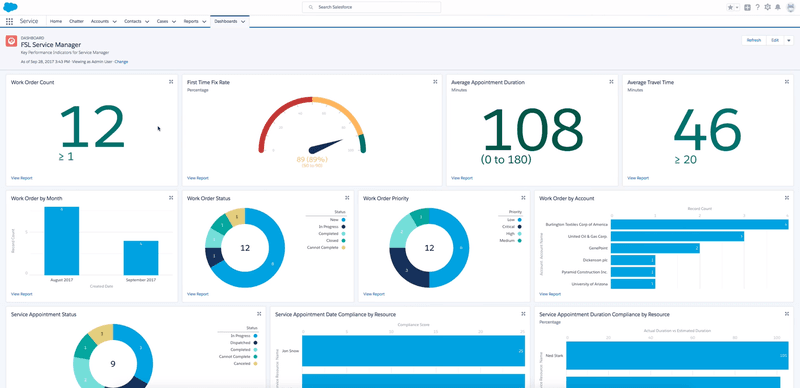
6. Typeform
Typeform is an online survey tool that SaaS teams can use to collect information and feedback from their customers. It’s known for its intuitive design and user-friendly navigation.
Typeform features include:
- Multiple question types (multiple choice, short text, long text, rating scales, file uploads, etc).
- Customization, so you can adjust colors, fonts, and images to align surveys with your branding.
- Built-in analytics to track completion rates, response times, etc., and custom reports.
- Multiple themes and templates.
- Real-time response monitoring and notifications.
- Integrations with applications like Google Analytics, Mailchimp, Zapier, Slack, and Salesforce to automate workflows and streamline data collection.
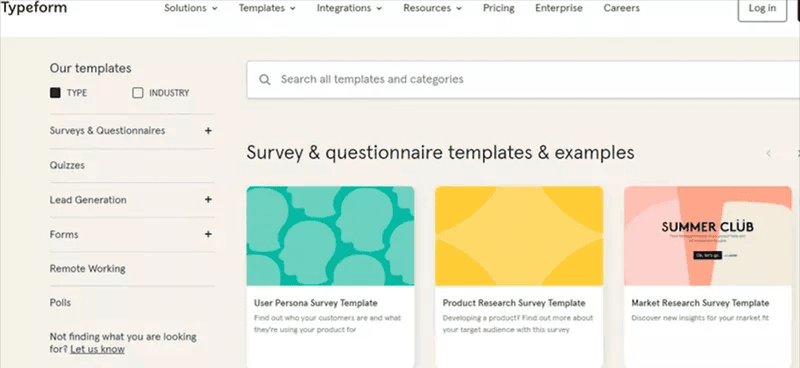
7. Qualaroo
Qualaroo is an advanced customer feedback and survey tool and a more complex alternative to Typeform.
It enables companies to create and deploy surveys that appear directly on their websites, mobile apps, or within their product interfaces. This means you can collect feedback at all stages of the customer journey contextually for more accurate and actionable insights.
What makes Qualaroo worth considering?
- Survey design customization for a seamless customer experience.
- Non-intrusive survey prompts called “Nudges” that help you boost response rates.
- Event-based survey triggering.
- Segmentation for survey targeting.
- A library of pre-built survey templates.
- AI-powered sentiment analysis.
- A centralized dashboard for real-time survey response analysis.
- Integrations with 3rd party tools like Google Analytics, Salesforce, and HubSpot.
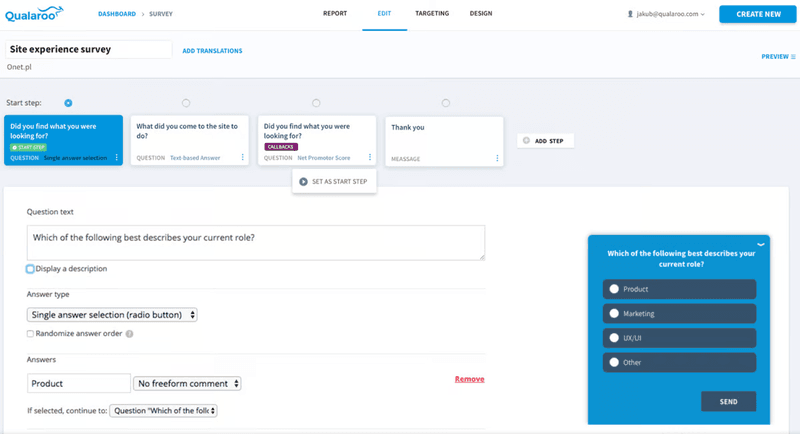
8. Mixpanel
Mixpanel is a powerful analytics platform. Its intuitive design makes it easier for non-technical users to track and analyze customer behavior across all customer journey touchpoints, which is what you need to optimize customer experience and make informed product decisions.
As you might expect, Mixpanel offers a ton of features:
- Behavioral segmentation.
- Industry-standard reports (Insights/Trends, Funnels, Retention, and Flows/Paths).
- Custom events.
- Multitouch attribution analysis.
- Root cause analysis.
- Experimentation (A/B testing).
- Campaign reporting for marketing channel performance analysis.
- AI Spark – a chat-based assistant which allows users to build reports by asking questions.
- Dozens of integrations with plenty of tools, many of which you’ve probably never heard about.
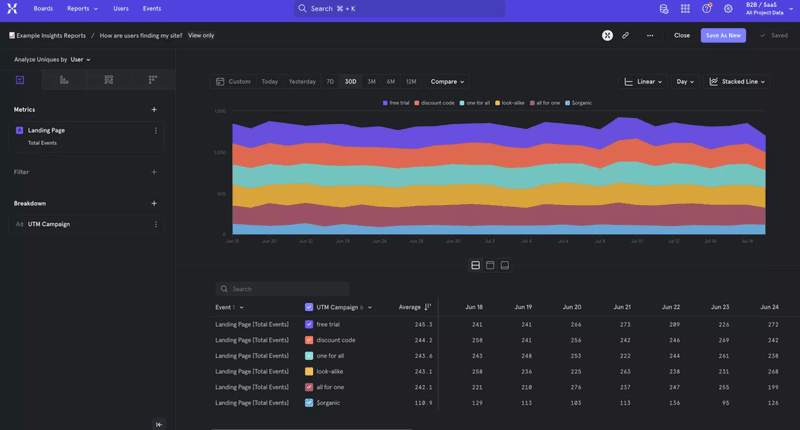
9. Amplitude
Amplitude is another leading analytics solution designed to help businesses understand user behavior, optimize user engagement, and drive growth through data-driven insights.
The platform has greater capabilities than Mixpanel but at the expense of user-friendliness. It’s not that it has usability issues, it’s just a bit more complex.
What features does it offer?
- Custom event tracking.
- Behavior-based segmentation (behavioral cohorts).
- Conversion drivers help attribute conversions to specific events and user actions.
- Root-cause analysis.
- Forecasting and anomaly detection.
- Campaign analysis.
- Session replays.
- Feature flags/toggles so that it’s easier to run experiments and personalize functionality.
- A/B and multivariate testing.
- Multiple integrations for data integration and workflow optimization.
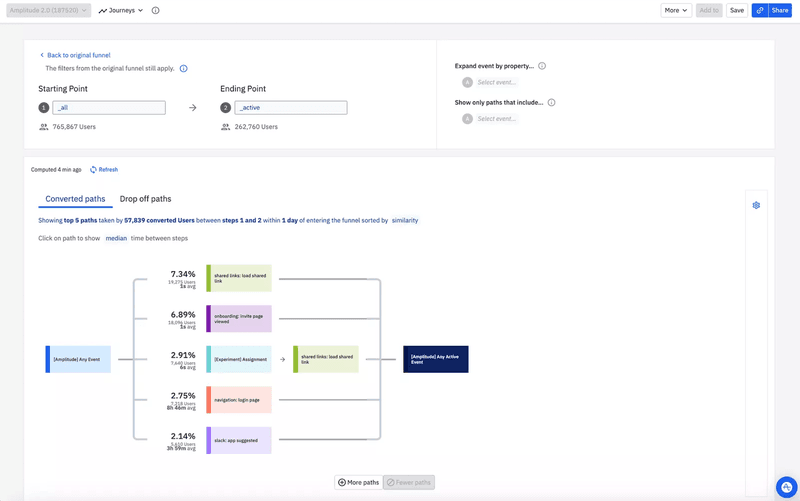
10. ActiveCampaign
ActiveCampaign is a marketing automation platform. It enables businesses to automate key aspects of their customer engagement strategies, personalize interactions, and ultimately enhance customer satisfaction and loyalty for long-term growth and reduced churn.
Teams looking to enhance their customer retention efforts can use it to:
- Design and send targeted email campaigns.
- Personalize email content based on user actions.
- A/B test different versions of their emails.
- Send personalized SMS messages.
- Trigger personalized messages on their websites.
- Provide automated support through chatbots.
- Track and analyze campaign performance from custom reports and dashboards.
ActiveCampaign offers plenty of integrations with analytics, CRM, and product growth platforms, so you can easily sync customer data between various tools for more granular segmentation and analysis.
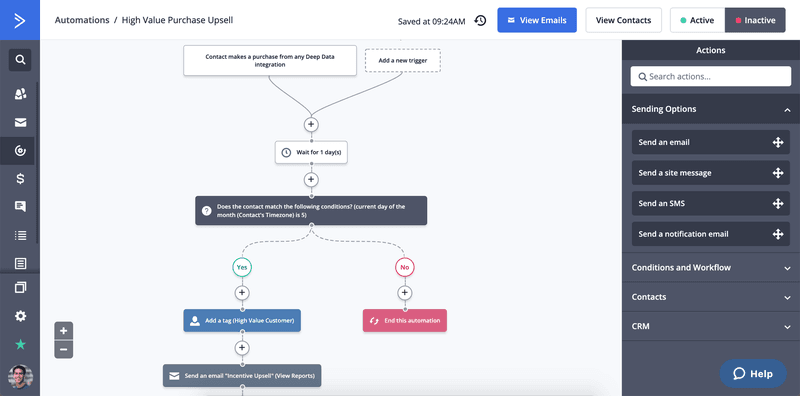
11. Brevo
Brevo, formerly Sendinblue, is a versatile marketing and customer relationship management (CRM) tool. It’s designed to streamline how your teams communicate with customers by providing a unified platform from which you manage all aspects of customer engagement.
Brevo allows you to:
- Create, send, and manage targeted email, SMS, and WhatsApp campaigns.
- Provide omnichannel customer support (via chatbots, live chat, WhatsApp, Instagram, and Facebook) and manage customer interactions from one unified inbox.
- Design automation workflows to engage with customers at the right time.
- Trigger communications based on user behavior.
- Integrate with 3rd party tools like Intercom, Salesforce, and Google Analytics.
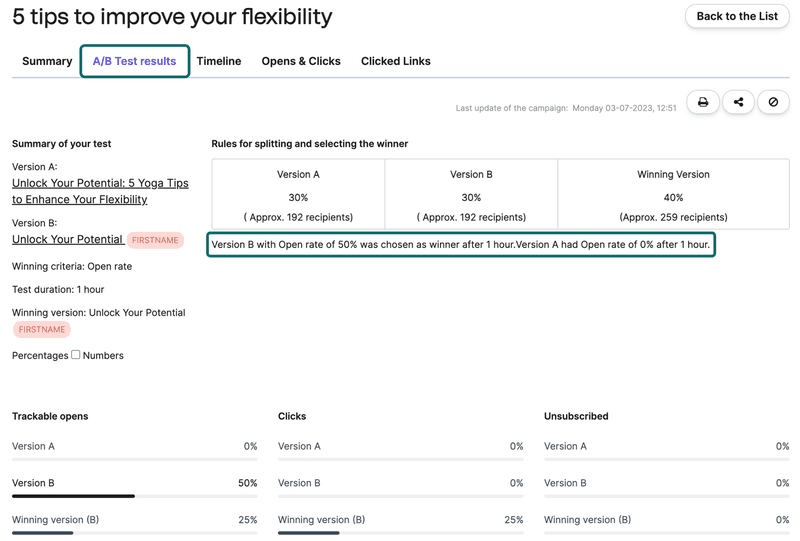
12. Open Loyalty
Open loyalty is a customer loyalty platform. SaaS companies can use them to create and manage personalized loyalty programs that drive customer retention.
How can you promote customer loyalty with Open Loyalty?
The tool allows you to set up:
- Points-based loyalty programs where customers can earn points and later redeem them for perks.
- Tiered reward systems where customers earn benefits.
- Referral programs that incentivize users to advocate for your product.
- Detailed customer profiles and segments for personalized engagement.
The platform also has analytics and reporting features so you can track the performance of your loyalty programs.
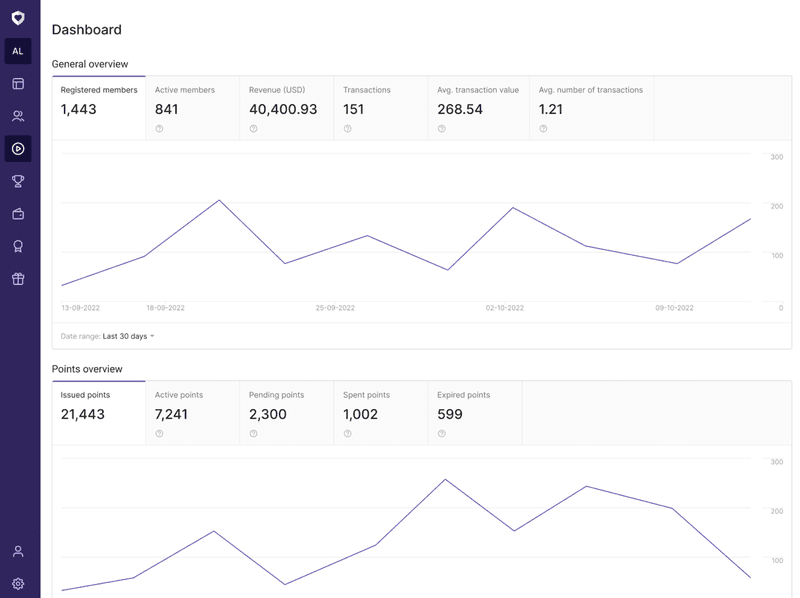
Conclusion
Improving customer retention consists of numerous processes: analyzing customer behavior and collecting feedback to understand their needs, engaging them effectively across multiple channels, and providing support so that they can realize product value.
To manage all of them, you need a range of tools. Some of them may help you address multiple needs and you should definitely try to consolidate as many of them as possible to avoid tech stack bloat.
Userpilot allows you to engage and assist users with in-app experiences informed by their behavior and feedback. If you’d like to learn more, book the demo!







